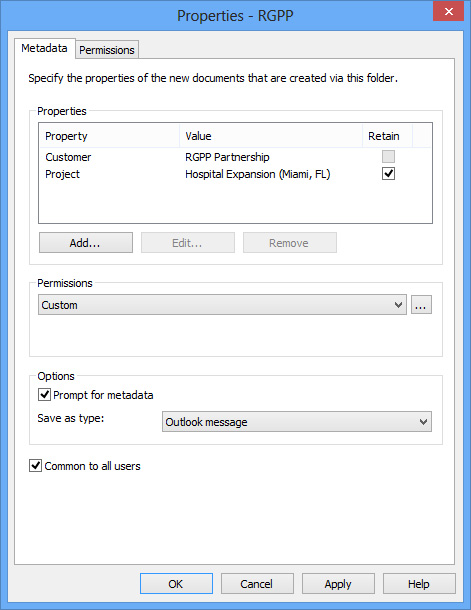You can specify automatically populated properties to be added to e-mail messages when you save them to M-Files by dragging them to M-Files folders in Outlook. These settings are folder-specific, allowing you to utilize multiple subfolders for a variety of use cases. The function is available in Microsoft Outlook 2007, 2010 and 2013.
Defining automatically populated metadata
You can find the Specify M-Files Properties function in Outlook by right-clicking an M-Files folder.

Properties dialog for setting up automatically populated, folder-specific metadata.
Click the Add... button to define a new property.
You can, for instance, use the property Project and set it to have the fixed value Zenith Construction Project. This way, the messages dragged into that folder are automatically associated with the Zenith Construction Project. Alternatively, if you wish to save all job applications in the Job application class, select the folder property Class and set its value to Job application.
You may also specify M-Files folder properties to be read from the e-mail message itself. In this case, select Add..., then the Read from the e-mail message option and choose a suitable field from the drop-down menu.
Allow users to retain the property value for this folder
This setting (visible only to users with at least the right to manage common views) adds a Retain column to the folder properties dialog. The Retain option is available for all users, and also controlled by each individual user. Activating the Retain option for a property tells M-Files to remember the latest value provided by the user, ignoring the original fixed value set by the administrator.
Let's say the organization is connected to two projects with the same customer, and the default project has been set to Alpha. The project manager for project Beta would probably want to enable the Retain option, because this way the property needs to be changed only once. After this, M-Files remembers that the project manager wants to associate his e-mails with project Beta, not Alpha, even though the default project was set to Alpha.
Permissions
The Permissions option enables you to define user permissions for the messages that are saved in this M-Files folder. This should not be confused with the view permissions for common folders (see below).
Prompt for metadata
You can specify whether the metadata card is to be displayed when messages are dragged into the M-Files folder. The metadata card should be displayed if you wish to check or modify automatically populated metadata during saving, or if you have not defined any folder-specific properties.
Specifying common M-Files folders
You can also specify that the M-Files subfolder you created is common to all users, in which case the folder will be displayed in Outlook to all users. A common M-Files subfolder can be created and specified by a user with at least the right to manage common views. When the user drags a message to a common folder, the message automatically receives the metadata (properties) that have been specified for the common folder.
The common folder settings are applied once the user starts Outlook while being logged into the vault.
Common folder view permissions
As soon as the Common to all users option has been enabled, the Permissions tab appears next to the Metadata tab. This allows you to select view permissions for the common folder. This should not be confused with the Permissions option on the Metadata tab (see above).